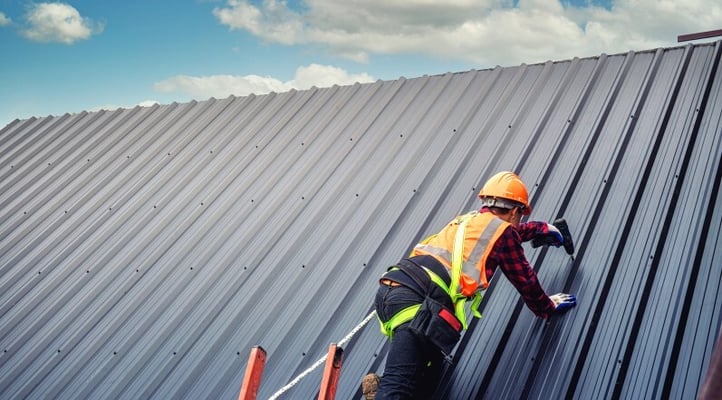- Home »
- Learningcenter »
- 7 practical tips to fix new roof leaks in heavy rain before major damage strikes
7 Practical Tips to Fix New Roof Leaks in Heavy Rain (Before Major Damage Strikes)

Picture this: You're enjoying a quiet evening at home when the rain starts pouring down. Suddenly, you hear the dreaded drip, drip, drip coming from your ceiling. Your heart sinks because this roof is practically brand new. How could this be happening?
You're not alone in this frustrating situation. About 30% of leaks in new roofs stem from installation errors, and water intrusion issues account for over 70% of construction litigation. The good news? Most new roof leaks are fixable when you know what to do and act quickly. That’s where professional inspection comes in.
At Colony Roofers, we've seen our fair share of panicked homeowners dealing with unexpected leaks during Georgia's heavy rainstorms. That's why we're sharing these seven practical tips to help you tackle the problem head-on and protect your home from further damage.
Why New Roofs Develop Leaks During Heavy Rain
Before we jump into solutions, let's understand why this happens. New roofs shouldn't leak, but when they do, it's usually due to one of these culprits:
Installation Errors Are More Common Than You Think
The reality is that even the most experienced roofers can make mistakes. Poor installation techniques, rushed work, or cutting corners during the process can leave vulnerable spots that only become apparent during the first major storm.
Material Defects Sometimes Slip Through Quality Control
Manufacturing defects in shingles, flashing, or underlayment can create weak points that fail under heavy rain pressure. While these issues are less common, they do occur and often show up within the first year.
Extreme Weather Tests Every Weakness
Heavy rain doesn't just test your roof's ability to shed water—it finds every tiny gap, loose seal, or improperly installed component. What might hold up during light rain can fail spectacularly during a downpour.
Are you dealing with a leak right now? Don't wait for the damage to spread. Contact Colony Roofers for roof repair services in Northern Georgia. We're available to help protect your home.
Tip #1: Identify the Leak Source Like a Pro
Finding where water is actually entering your roof can be tricky because water doesn't always drip directly below the entry point. It can travel along roof decking, rafters, or pipes before showing up somewhere completely different.
Start Your Investigation Inside
Look for these telltale signs:
- Water stains on ceilings or walls
- Damp spots that feel soft to the touch
- Discolored paint or wallpaper
- Musty odors in certain rooms
Move Your Search Outside
Once you've identified the general area inside, head outside (when it's safe) to examine:
- Flashing around chimneys, vents, and skylights - This is where 40% of roof leaks originate
- Shingles that appear cracked, curled, or missing
- Roof valleys where debris might accumulate
- Areas around roof penetrations, like satellite dishes or pipes
Pro tip: Take photos of any damage you spot. This documentation will be helpful when working with your roofing contractor or insurance company.
Tip #2: Master the Art of Temporary Fixes
When rain is actively coming through your roof, you need immediate damage control. These temporary solutions won't permanently fix the problem, but they'll buy you time until professional help arrives.
The Bucket Brigade Method
Place containers strategically to catch dripping water and prevent floor damage. Use towels around the base to absorb splashing. Empty containers regularly to prevent overflow.
Tarp It Up (The Right Way)
If you can safely access your roof, a tarp can be a lifesaver:
- Use a heavy-duty tarp that extends at least 4 feet beyond the damaged area
- Secure with roofing nails or heavy weights - never use duct tape alone
- Ensure the tarp extends over the roof ridge, if possible, for maximum protection
Quick Seal Solutions
For small, visible leaks, roofing cement or caulk can provide temporary relief. Apply generously around the affected area, but remember this is just a Band-Aid solution.
Safety Warning: Never attempt roof work during active storms or on wet surfaces. Your safety is more important than preventing water damage.
Tip #3: Address Flashing Issues Before They Escalate
Flashing problems are responsible for a significant portion of new roof leaks. These metal strips direct water away from roof joints and penetrations, but they're also common failure points.
Common Flashing Trouble Spots
Chimney flashing often develops gaps where the metal meets the masonry. Vent flashing can pull away from pipes due to thermal expansion. Valley flashing may have been improperly installed or damaged during construction.
Temporary Flashing Fixes
If you suspect flashing issues, apply roofing cement liberally around the suspected area. For larger gaps, you might need to use a piece of sheet metal as a temporary patch, secured with roofing cement.
Tip #4: Don't Ignore Your Gutters and Drainage
Clogged gutters can cause water to back up under your shingles, creating leaks that appear to come from the roof itself. This is especially problematic during heavy rain when the volume of water overwhelms blocked drainage systems.
Quick Gutter Assessment
During or immediately after heavy rain, check if:
- Water is overflowing from gutters
- Downspouts are backing up
- Water is pooling against your home's foundation
Emergency Drainage Solutions
If gutters are clogged, remove visible debris by hand (when safe to do so). For downspout blockages, try using a garden hose to flush out the obstruction from the bottom up.
Need immediate gutter cleaning or repair? Colony Roofers offers comprehensive gutter services alongside our roofing expertise. Don't let clogged gutters turn a minor issue into major water damage.
Tip #5: Handle Shingle Problems Strategically
Missing, cracked, or curled shingles are often the most visible signs of roof problems. While you can't perform permanent repairs during a storm, you can minimize damage.
Assess Shingle Damage Safely
From the ground or through binoculars, look for:
- Shingles that are completely missing
- Visible cracks or splits
- Curled edges that create gaps
- Granule loss that exposes the underlying material
Temporary Shingle Solutions
For missing shingles, slide a piece of sheet metal or heavy plastic under the surrounding shingles to create a temporary barrier. Secure with roofing cement if you can access the area safely.
Tip #6: Leverage 2025 Technology for Better Detection
The roofing industry has embraced cutting-edge technology that can help identify and address leaks more effectively than ever before.
Smart Roof Monitoring Systems
IoT sensors can now monitor temperature, humidity, and moisture levels in real-time, alerting you to potential problems before they become visible leaks. While this technology is still emerging, forward-thinking homeowners are starting to invest in these systems.
Drone Inspections Save Time and Increase Safety
Professional drone inspections allow us to assess roof conditions without putting anyone at risk. We can identify problems that might be missed during traditional visual inspections and provide detailed documentation of your roof's condition.
Self-Healing Materials Are Changing the Game
Some of the latest roofing materials incorporate thermoplastic compounds that can seal minor damage automatically when exposed to heat. While not yet widely available, these materials represent the future of leak prevention.
<h2>Tip #7: Plan Your Long-Term Prevention Strategy</h2>
Temporary fixes are just the beginning. To prevent future leaks and protect your investment, you need a comprehensive long-term approach.
Schedule Regular Professional Inspections
Annual roof inspections are crucial, especially for new roofs that may still have warranty coverage. As Werner Roofing notes, "Leaks in new roofs are rare and often easy to fix if addressed promptly."
Maintain Your Roof Year-Round
Regular maintenance prevents most leak problems:
- Clean gutters and downspouts quarterly
- Remove debris from roof valleys and surfaces
- Trim overhanging tree branches
- Check and reseal penetrations annually
Document Everything for Warranty Claims
Keep detailed records of your roof installation, any repairs, and maintenance activities. This documentation is essential if you need to file warranty claims or insurance reports.
Understanding When to Call the Professionals
While these tips can help you manage immediate problems, some situations require professional intervention:
- Extensive damage covering multiple shingles or large areas
- Structural concerns like sagging or damaged decking
- Electrical hazards from water near wiring or fixtures
- Safety risks that prevent you from accessing problem areas
Remember, roofs last only about half their designed lifetime on average, often due to delayed maintenance and repairs. Don't let a small problem become a major expense.
Frequently Asked Questions About New Roof Leaks
Q: How common are leaks in brand new roofs? A: While not extremely common, research indicates that about 30% of new roof leaks are due to installation errors or material defects. Most are easily fixable when addressed promptly.
Q: Should I file an insurance claim for a new roof leak? A: This depends on the cause and extent of damage. Installation errors may be covered under your contractor's warranty, while storm damage might fall under your homeowner's insurance. Document everything and consult with professionals.
Q: How quickly do I need to address a roof leak? A: Immediately. Even small leaks can cause significant damage to insulation, drywall, and structural elements if left untreated. Water damage can begin within hours of a leak starting.
Q: Can I prevent leaks in a new roof? A: Yes, through proper installation, quality materials, and regular maintenance. Annual inspections and prompt attention to minor issues can prevent most leak problems.
Q: What's the typical cost range for fixing a new roof leak? A: Repair costs vary widely depending on the extent of damage and type of repair needed. Simple fixes might be relatively inexpensive, while extensive repairs could cost significantly more.
Q: How do I know if my roof leak is covered under warranty? A: Check your roofing contract and warranty documentation. Most reputable contractors provide warranties on their workmanship, which should cover installation-related leaks.
Take Action Before the Next Storm Hits
Don't wait for the next heavy rain to test your roof's limits. Proactive maintenance and quick response to problems are your best defense against costly water damage.
At Colony Roofers, we've been protecting Northern Georgia homes since 2018 with quality workmanship and exceptional customer service. Our family-owned business understands the stress that roof problems can cause, and we're here to help you find lasting solutions.
Ready to protect your home? Contact Colony Roofers today for a comprehensive roof inspection. We'll identify potential problems before they become expensive headaches and ensure your roof is ready for whatever Mother Nature sends your way.
Whether you need repairs, routine maintenance, or want to explore the latest roofing technologies, our experienced team is here to help. Don't let a small leak turn into a major disaster—reach out to us today.
Name, Address and Phone
Colony Roofers
260 Peachtree St NW Suite 2200, Atlanta, GA 30303
470-465-9624
Social Media
https://www.facebook.com/colonyroofersllc/,
https://www.yelp.com/biz/colony-roofers-atlanta-4,
https://www.youtube.com/@colonyroofers4604,
https://www.bbb.org/us/ga/atlanta/profile/roofing-contractors/colony-roofers-0443-27774108,
 Call (678) 365-3138
Call (678) 365-3138


